Comprehensive Report on Accounting, Finance, and Business Expansion
VerifiedAdded on 2023/06/15
|22
|4770
|409
Report
AI Summary
This report provides a detailed analysis of accounting and finance principles, focusing on business analysis, financial ratios, and expansion strategies. It examines various funding sources for start-up and ongoing businesses, including personal investments, loans, venture capital, and grants. The report evaluates profitability ratios like return on equity and operating profit margin, efficiency ratios such as average inventory turnover, liquidity ratios like current and acid-test ratios, leverage ratios including gearing and interest cover, and investment ratios like dividend payout and yield. The analysis includes a three-year comparison (2019-2021) to identify trends and assess the financial health of a company. Desklib offers a platform to explore similar documents and enhance understanding of accounting and finance concepts.
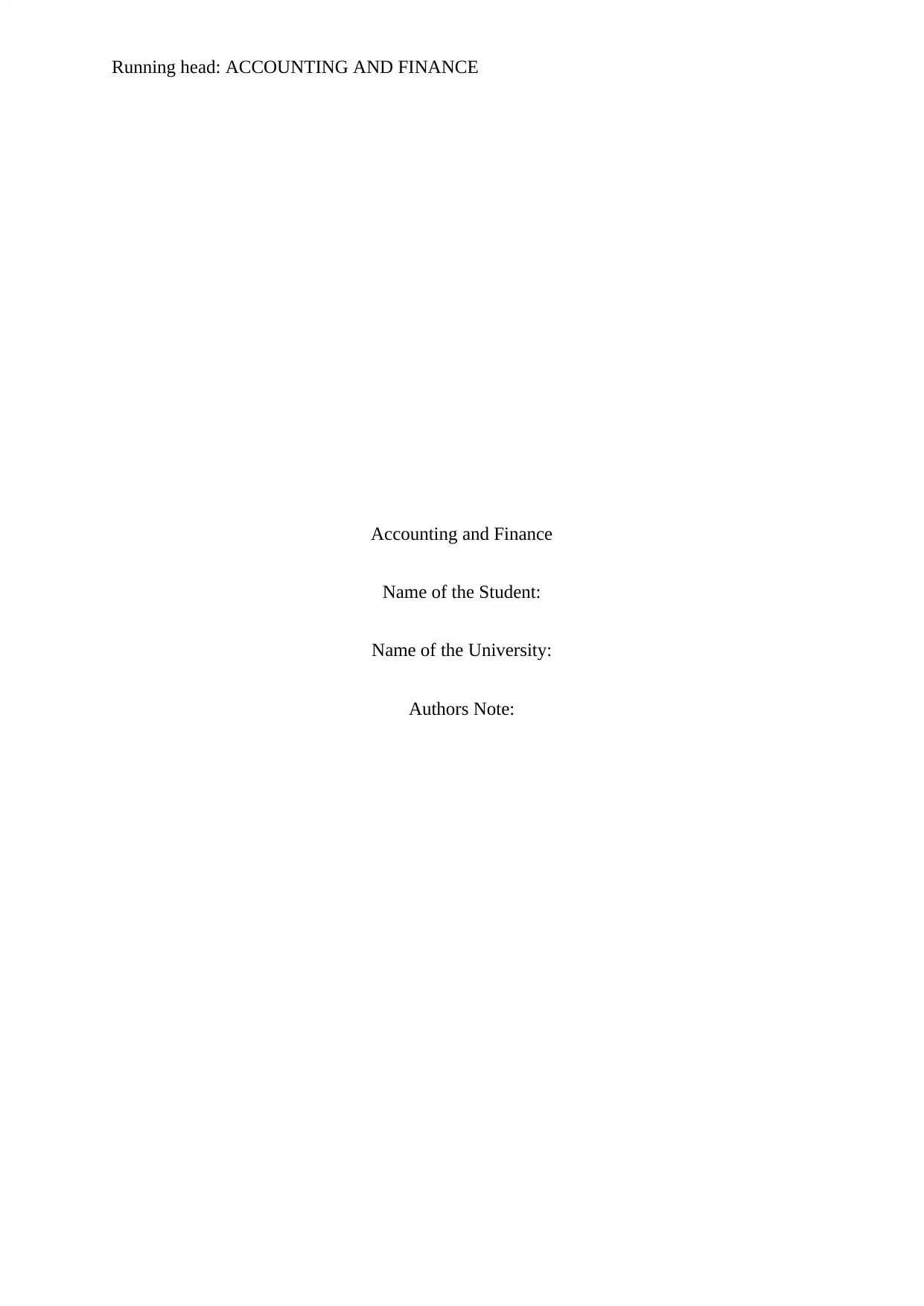
Running head: ACCOUNTING AND FINANCE
Accounting and Finance
Name of the Student:
Name of the University:
Authors Note:
Accounting and Finance
Name of the Student:
Name of the University:
Authors Note:
Paraphrase This Document
Need a fresh take? Get an instant paraphrase of this document with our AI Paraphraser
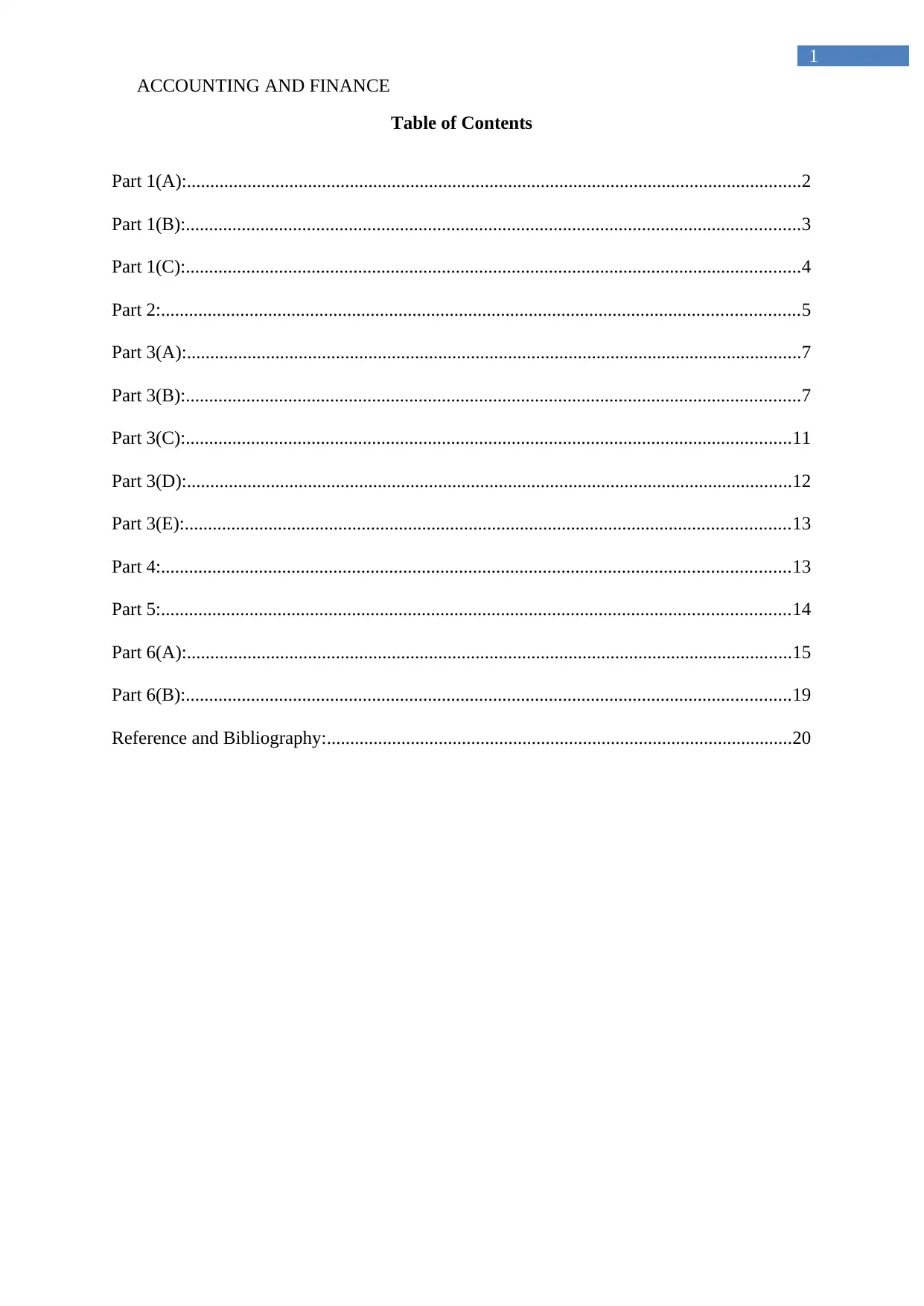
ACCOUNTING AND FINANCE
1
Table of Contents
Part 1(A):....................................................................................................................................2
Part 1(B):....................................................................................................................................3
Part 1(C):....................................................................................................................................4
Part 2:.........................................................................................................................................5
Part 3(A):....................................................................................................................................7
Part 3(B):....................................................................................................................................7
Part 3(C):..................................................................................................................................11
Part 3(D):..................................................................................................................................12
Part 3(E):..................................................................................................................................13
Part 4:.......................................................................................................................................13
Part 5:.......................................................................................................................................14
Part 6(A):..................................................................................................................................15
Part 6(B):..................................................................................................................................19
Reference and Bibliography:....................................................................................................20
1
Table of Contents
Part 1(A):....................................................................................................................................2
Part 1(B):....................................................................................................................................3
Part 1(C):....................................................................................................................................4
Part 2:.........................................................................................................................................5
Part 3(A):....................................................................................................................................7
Part 3(B):....................................................................................................................................7
Part 3(C):..................................................................................................................................11
Part 3(D):..................................................................................................................................12
Part 3(E):..................................................................................................................................13
Part 4:.......................................................................................................................................13
Part 5:.......................................................................................................................................14
Part 6(A):..................................................................................................................................15
Part 6(B):..................................................................................................................................19
Reference and Bibliography:....................................................................................................20
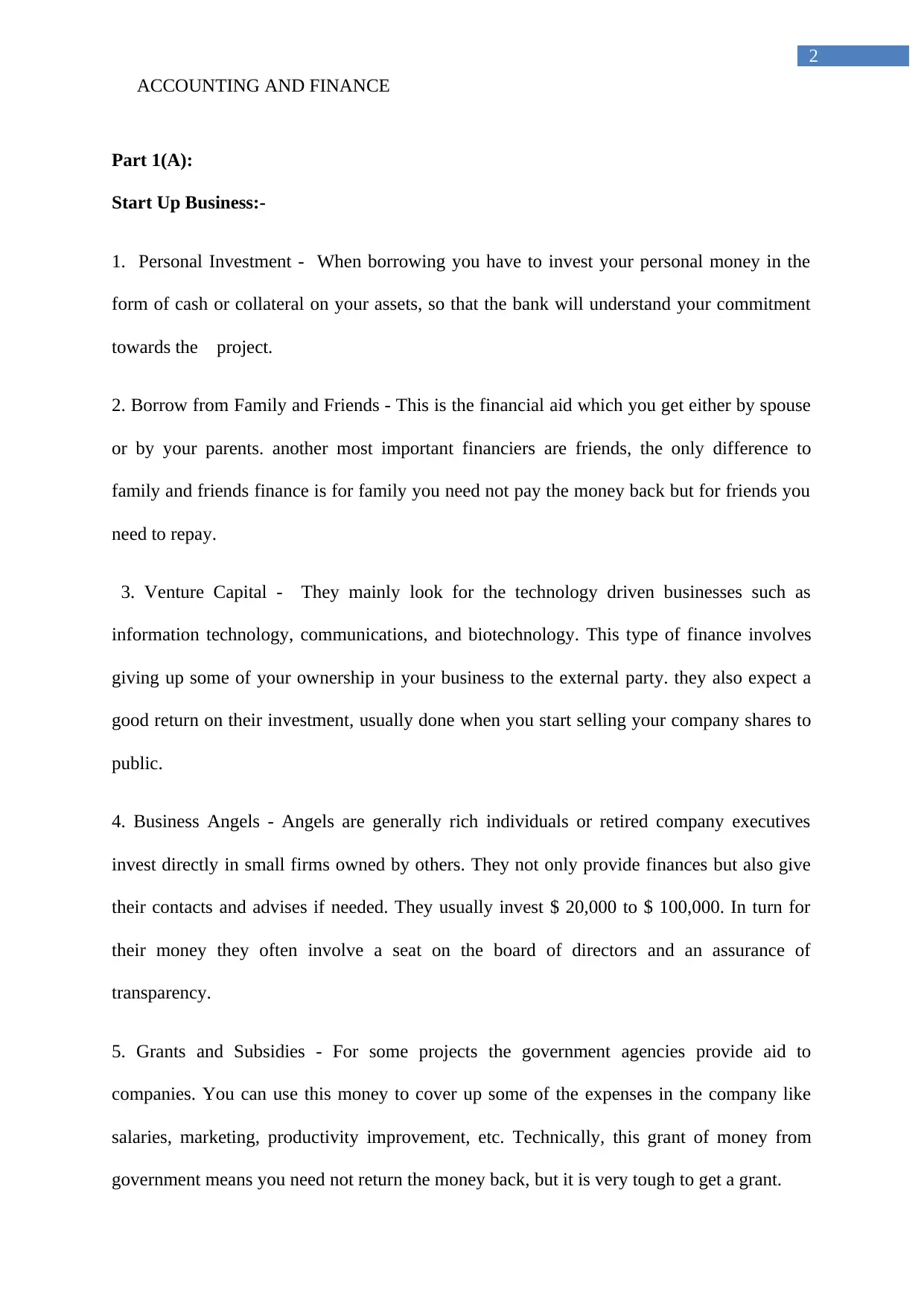
ACCOUNTING AND FINANCE
2
Part 1(A):
Start Up Business:-
1. Personal Investment - When borrowing you have to invest your personal money in the
form of cash or collateral on your assets, so that the bank will understand your commitment
towards the project.
2. Borrow from Family and Friends - This is the financial aid which you get either by spouse
or by your parents. another most important financiers are friends, the only difference to
family and friends finance is for family you need not pay the money back but for friends you
need to repay.
3. Venture Capital - They mainly look for the technology driven businesses such as
information technology, communications, and biotechnology. This type of finance involves
giving up some of your ownership in your business to the external party. they also expect a
good return on their investment, usually done when you start selling your company shares to
public.
4. Business Angels - Angels are generally rich individuals or retired company executives
invest directly in small firms owned by others. They not only provide finances but also give
their contacts and advises if needed. They usually invest $ 20,000 to $ 100,000. In turn for
their money they often involve a seat on the board of directors and an assurance of
transparency.
5. Grants and Subsidies - For some projects the government agencies provide aid to
companies. You can use this money to cover up some of the expenses in the company like
salaries, marketing, productivity improvement, etc. Technically, this grant of money from
government means you need not return the money back, but it is very tough to get a grant.
2
Part 1(A):
Start Up Business:-
1. Personal Investment - When borrowing you have to invest your personal money in the
form of cash or collateral on your assets, so that the bank will understand your commitment
towards the project.
2. Borrow from Family and Friends - This is the financial aid which you get either by spouse
or by your parents. another most important financiers are friends, the only difference to
family and friends finance is for family you need not pay the money back but for friends you
need to repay.
3. Venture Capital - They mainly look for the technology driven businesses such as
information technology, communications, and biotechnology. This type of finance involves
giving up some of your ownership in your business to the external party. they also expect a
good return on their investment, usually done when you start selling your company shares to
public.
4. Business Angels - Angels are generally rich individuals or retired company executives
invest directly in small firms owned by others. They not only provide finances but also give
their contacts and advises if needed. They usually invest $ 20,000 to $ 100,000. In turn for
their money they often involve a seat on the board of directors and an assurance of
transparency.
5. Grants and Subsidies - For some projects the government agencies provide aid to
companies. You can use this money to cover up some of the expenses in the company like
salaries, marketing, productivity improvement, etc. Technically, this grant of money from
government means you need not return the money back, but it is very tough to get a grant.
⊘ This is a preview!⊘
Do you want full access?
Subscribe today to unlock all pages.

Trusted by 1+ million students worldwide
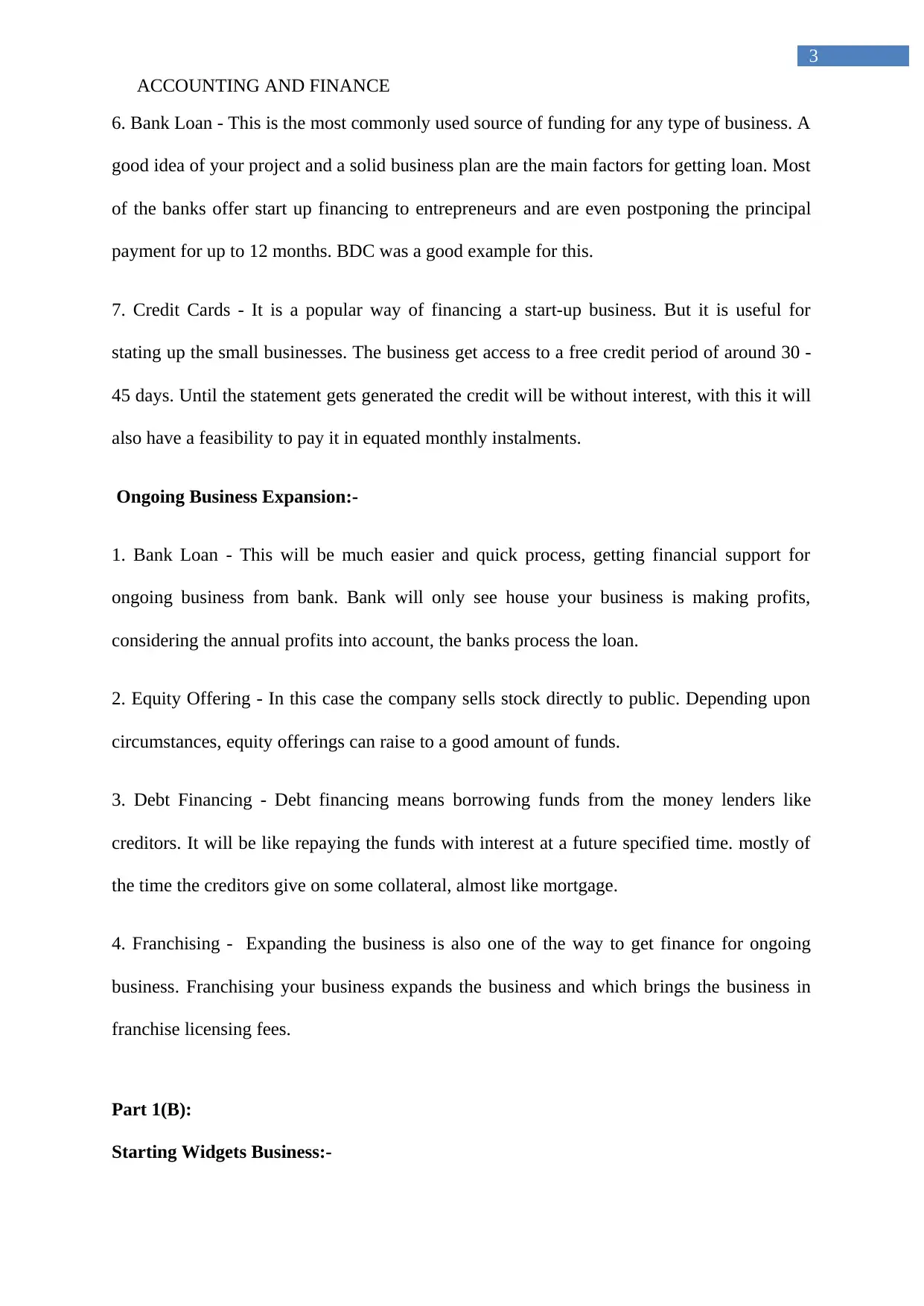
ACCOUNTING AND FINANCE
3
6. Bank Loan - This is the most commonly used source of funding for any type of business. A
good idea of your project and a solid business plan are the main factors for getting loan. Most
of the banks offer start up financing to entrepreneurs and are even postponing the principal
payment for up to 12 months. BDC was a good example for this.
7. Credit Cards - It is a popular way of financing a start-up business. But it is useful for
stating up the small businesses. The business get access to a free credit period of around 30 -
45 days. Until the statement gets generated the credit will be without interest, with this it will
also have a feasibility to pay it in equated monthly instalments.
Ongoing Business Expansion:-
1. Bank Loan - This will be much easier and quick process, getting financial support for
ongoing business from bank. Bank will only see house your business is making profits,
considering the annual profits into account, the banks process the loan.
2. Equity Offering - In this case the company sells stock directly to public. Depending upon
circumstances, equity offerings can raise to a good amount of funds.
3. Debt Financing - Debt financing means borrowing funds from the money lenders like
creditors. It will be like repaying the funds with interest at a future specified time. mostly of
the time the creditors give on some collateral, almost like mortgage.
4. Franchising - Expanding the business is also one of the way to get finance for ongoing
business. Franchising your business expands the business and which brings the business in
franchise licensing fees.
Part 1(B):
Starting Widgets Business:-
3
6. Bank Loan - This is the most commonly used source of funding for any type of business. A
good idea of your project and a solid business plan are the main factors for getting loan. Most
of the banks offer start up financing to entrepreneurs and are even postponing the principal
payment for up to 12 months. BDC was a good example for this.
7. Credit Cards - It is a popular way of financing a start-up business. But it is useful for
stating up the small businesses. The business get access to a free credit period of around 30 -
45 days. Until the statement gets generated the credit will be without interest, with this it will
also have a feasibility to pay it in equated monthly instalments.
Ongoing Business Expansion:-
1. Bank Loan - This will be much easier and quick process, getting financial support for
ongoing business from bank. Bank will only see house your business is making profits,
considering the annual profits into account, the banks process the loan.
2. Equity Offering - In this case the company sells stock directly to public. Depending upon
circumstances, equity offerings can raise to a good amount of funds.
3. Debt Financing - Debt financing means borrowing funds from the money lenders like
creditors. It will be like repaying the funds with interest at a future specified time. mostly of
the time the creditors give on some collateral, almost like mortgage.
4. Franchising - Expanding the business is also one of the way to get finance for ongoing
business. Franchising your business expands the business and which brings the business in
franchise licensing fees.
Part 1(B):
Starting Widgets Business:-
Paraphrase This Document
Need a fresh take? Get an instant paraphrase of this document with our AI Paraphraser
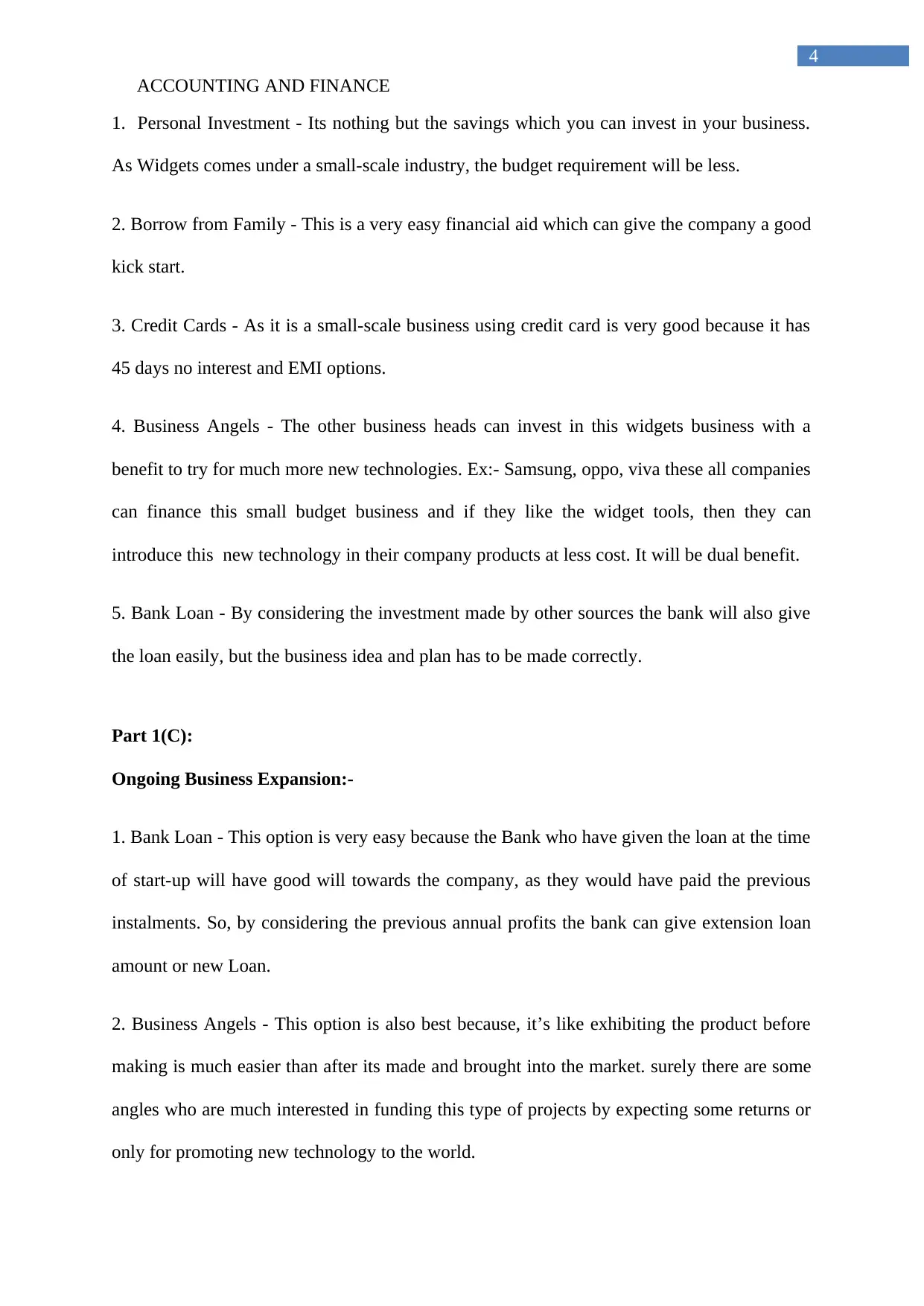
ACCOUNTING AND FINANCE
4
1. Personal Investment - Its nothing but the savings which you can invest in your business.
As Widgets comes under a small-scale industry, the budget requirement will be less.
2. Borrow from Family - This is a very easy financial aid which can give the company a good
kick start.
3. Credit Cards - As it is a small-scale business using credit card is very good because it has
45 days no interest and EMI options.
4. Business Angels - The other business heads can invest in this widgets business with a
benefit to try for much more new technologies. Ex:- Samsung, oppo, viva these all companies
can finance this small budget business and if they like the widget tools, then they can
introduce this new technology in their company products at less cost. It will be dual benefit.
5. Bank Loan - By considering the investment made by other sources the bank will also give
the loan easily, but the business idea and plan has to be made correctly.
Part 1(C):
Ongoing Business Expansion:-
1. Bank Loan - This option is very easy because the Bank who have given the loan at the time
of start-up will have good will towards the company, as they would have paid the previous
instalments. So, by considering the previous annual profits the bank can give extension loan
amount or new Loan.
2. Business Angels - This option is also best because, it’s like exhibiting the product before
making is much easier than after its made and brought into the market. surely there are some
angles who are much interested in funding this type of projects by expecting some returns or
only for promoting new technology to the world.
4
1. Personal Investment - Its nothing but the savings which you can invest in your business.
As Widgets comes under a small-scale industry, the budget requirement will be less.
2. Borrow from Family - This is a very easy financial aid which can give the company a good
kick start.
3. Credit Cards - As it is a small-scale business using credit card is very good because it has
45 days no interest and EMI options.
4. Business Angels - The other business heads can invest in this widgets business with a
benefit to try for much more new technologies. Ex:- Samsung, oppo, viva these all companies
can finance this small budget business and if they like the widget tools, then they can
introduce this new technology in their company products at less cost. It will be dual benefit.
5. Bank Loan - By considering the investment made by other sources the bank will also give
the loan easily, but the business idea and plan has to be made correctly.
Part 1(C):
Ongoing Business Expansion:-
1. Bank Loan - This option is very easy because the Bank who have given the loan at the time
of start-up will have good will towards the company, as they would have paid the previous
instalments. So, by considering the previous annual profits the bank can give extension loan
amount or new Loan.
2. Business Angels - This option is also best because, it’s like exhibiting the product before
making is much easier than after its made and brought into the market. surely there are some
angles who are much interested in funding this type of projects by expecting some returns or
only for promoting new technology to the world.
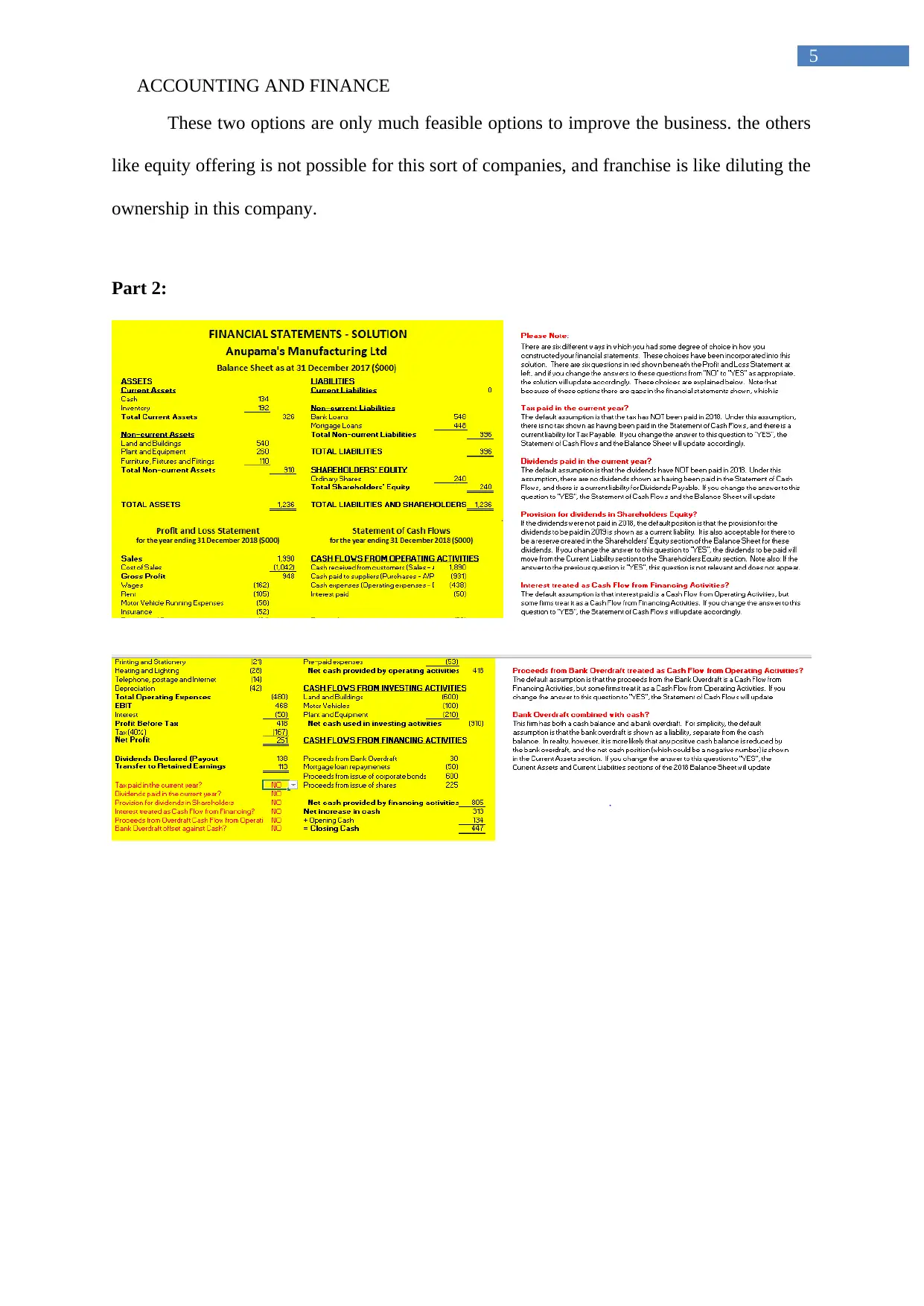
ACCOUNTING AND FINANCE
5
These two options are only much feasible options to improve the business. the others
like equity offering is not possible for this sort of companies, and franchise is like diluting the
ownership in this company.
Part 2:
5
These two options are only much feasible options to improve the business. the others
like equity offering is not possible for this sort of companies, and franchise is like diluting the
ownership in this company.
Part 2:
⊘ This is a preview!⊘
Do you want full access?
Subscribe today to unlock all pages.

Trusted by 1+ million students worldwide
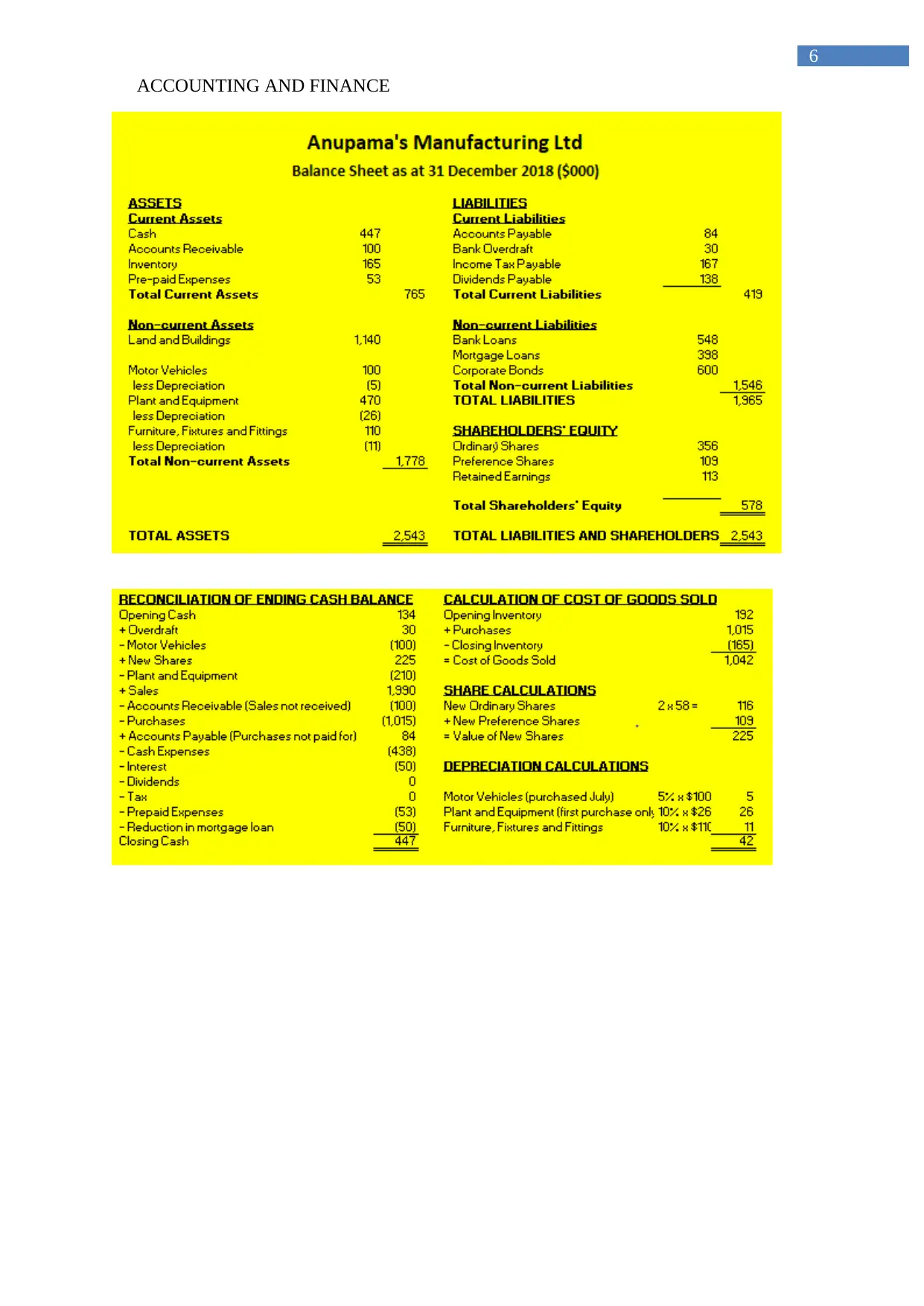
ACCOUNTING AND FINANCE
6
6
Paraphrase This Document
Need a fresh take? Get an instant paraphrase of this document with our AI Paraphraser
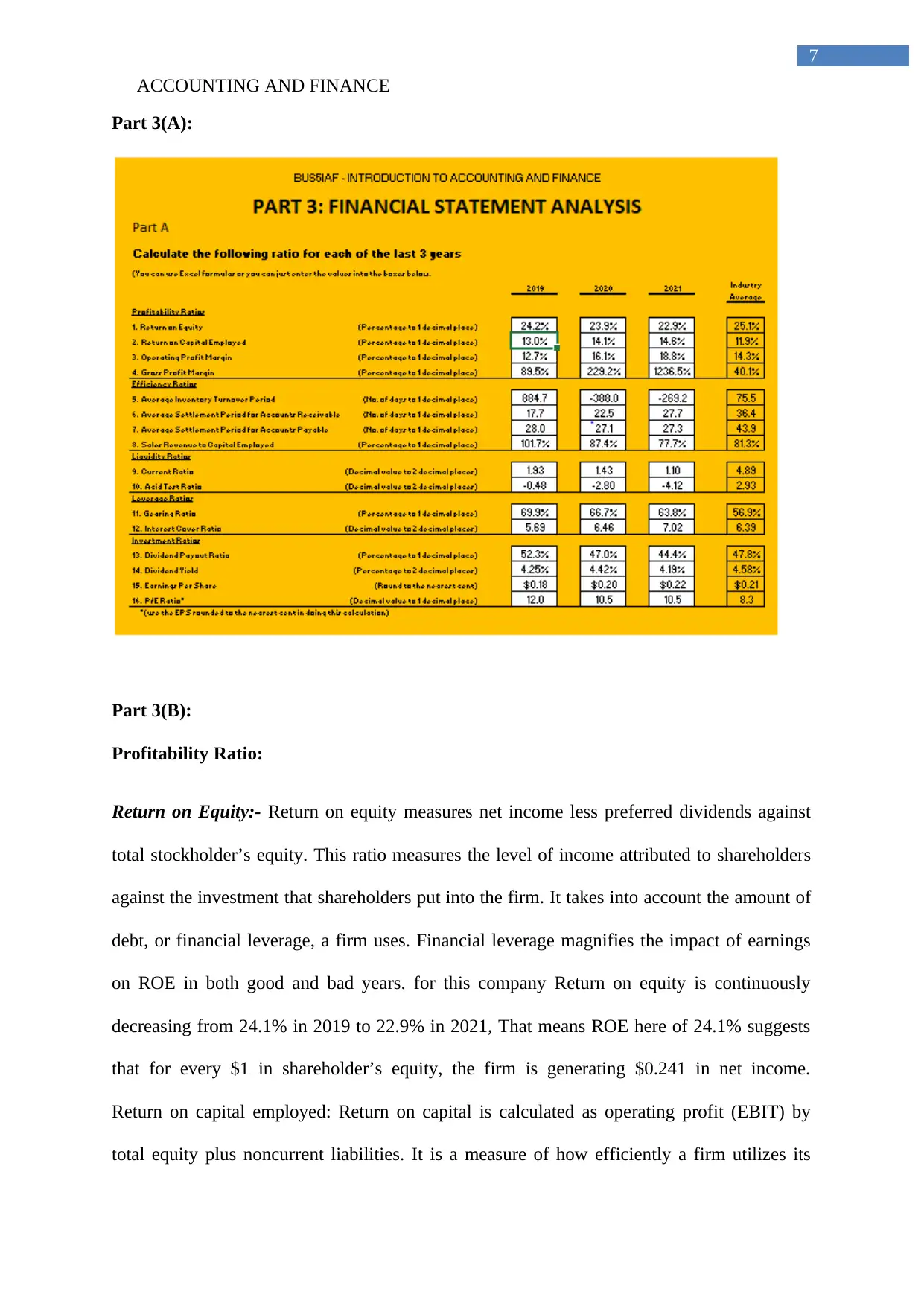
ACCOUNTING AND FINANCE
7
Part 3(A):
Part 3(B):
Profitability Ratio:
Return on Equity:- Return on equity measures net income less preferred dividends against
total stockholder’s equity. This ratio measures the level of income attributed to shareholders
against the investment that shareholders put into the firm. It takes into account the amount of
debt, or financial leverage, a firm uses. Financial leverage magnifies the impact of earnings
on ROE in both good and bad years. for this company Return on equity is continuously
decreasing from 24.1% in 2019 to 22.9% in 2021, That means ROE here of 24.1% suggests
that for every $1 in shareholder’s equity, the firm is generating $0.241 in net income.
Return on capital employed: Return on capital is calculated as operating profit (EBIT) by
total equity plus noncurrent liabilities. It is a measure of how efficiently a firm utilizes its
7
Part 3(A):
Part 3(B):
Profitability Ratio:
Return on Equity:- Return on equity measures net income less preferred dividends against
total stockholder’s equity. This ratio measures the level of income attributed to shareholders
against the investment that shareholders put into the firm. It takes into account the amount of
debt, or financial leverage, a firm uses. Financial leverage magnifies the impact of earnings
on ROE in both good and bad years. for this company Return on equity is continuously
decreasing from 24.1% in 2019 to 22.9% in 2021, That means ROE here of 24.1% suggests
that for every $1 in shareholder’s equity, the firm is generating $0.241 in net income.
Return on capital employed: Return on capital is calculated as operating profit (EBIT) by
total equity plus noncurrent liabilities. It is a measure of how efficiently a firm utilizes its
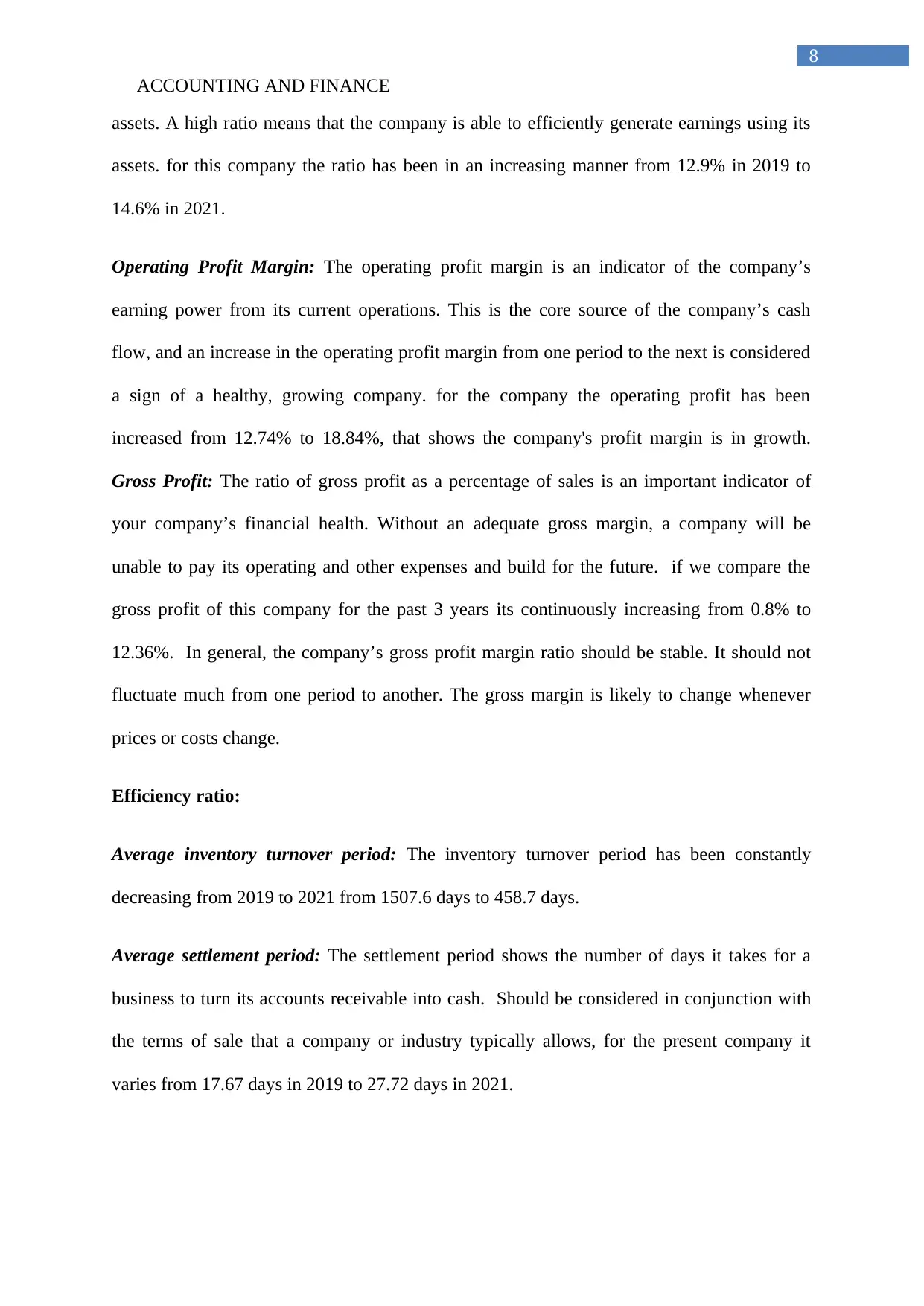
ACCOUNTING AND FINANCE
8
assets. A high ratio means that the company is able to efficiently generate earnings using its
assets. for this company the ratio has been in an increasing manner from 12.9% in 2019 to
14.6% in 2021.
Operating Profit Margin: The operating profit margin is an indicator of the company’s
earning power from its current operations. This is the core source of the company’s cash
flow, and an increase in the operating profit margin from one period to the next is considered
a sign of a healthy, growing company. for the company the operating profit has been
increased from 12.74% to 18.84%, that shows the company's profit margin is in growth.
Gross Profit: The ratio of gross profit as a percentage of sales is an important indicator of
your company’s financial health. Without an adequate gross margin, a company will be
unable to pay its operating and other expenses and build for the future. if we compare the
gross profit of this company for the past 3 years its continuously increasing from 0.8% to
12.36%. In general, the company’s gross profit margin ratio should be stable. It should not
fluctuate much from one period to another. The gross margin is likely to change whenever
prices or costs change.
Efficiency ratio:
Average inventory turnover period: The inventory turnover period has been constantly
decreasing from 2019 to 2021 from 1507.6 days to 458.7 days.
Average settlement period: The settlement period shows the number of days it takes for a
business to turn its accounts receivable into cash. Should be considered in conjunction with
the terms of sale that a company or industry typically allows, for the present company it
varies from 17.67 days in 2019 to 27.72 days in 2021.
8
assets. A high ratio means that the company is able to efficiently generate earnings using its
assets. for this company the ratio has been in an increasing manner from 12.9% in 2019 to
14.6% in 2021.
Operating Profit Margin: The operating profit margin is an indicator of the company’s
earning power from its current operations. This is the core source of the company’s cash
flow, and an increase in the operating profit margin from one period to the next is considered
a sign of a healthy, growing company. for the company the operating profit has been
increased from 12.74% to 18.84%, that shows the company's profit margin is in growth.
Gross Profit: The ratio of gross profit as a percentage of sales is an important indicator of
your company’s financial health. Without an adequate gross margin, a company will be
unable to pay its operating and other expenses and build for the future. if we compare the
gross profit of this company for the past 3 years its continuously increasing from 0.8% to
12.36%. In general, the company’s gross profit margin ratio should be stable. It should not
fluctuate much from one period to another. The gross margin is likely to change whenever
prices or costs change.
Efficiency ratio:
Average inventory turnover period: The inventory turnover period has been constantly
decreasing from 2019 to 2021 from 1507.6 days to 458.7 days.
Average settlement period: The settlement period shows the number of days it takes for a
business to turn its accounts receivable into cash. Should be considered in conjunction with
the terms of sale that a company or industry typically allows, for the present company it
varies from 17.67 days in 2019 to 27.72 days in 2021.
⊘ This is a preview!⊘
Do you want full access?
Subscribe today to unlock all pages.

Trusted by 1+ million students worldwide
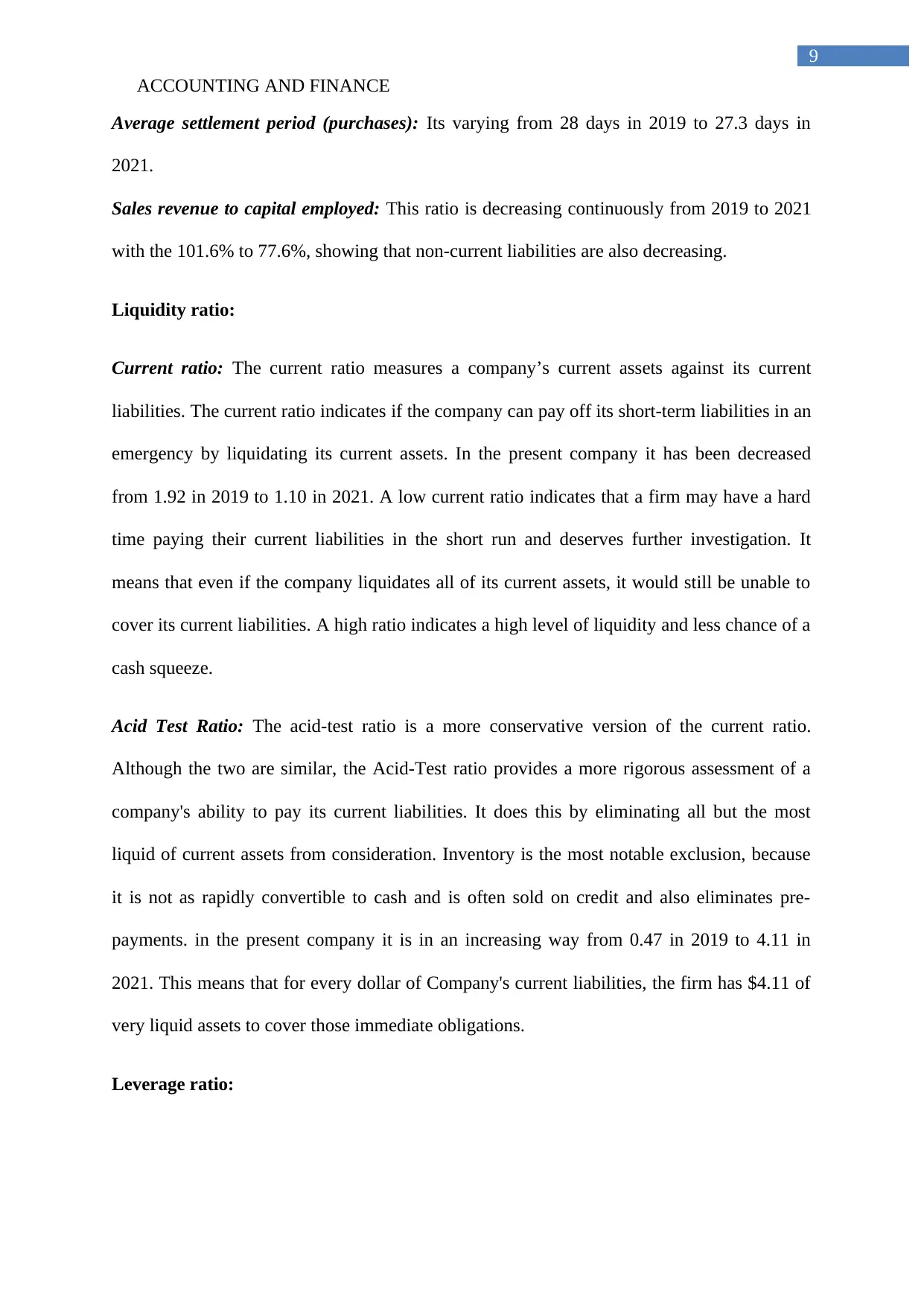
ACCOUNTING AND FINANCE
9
Average settlement period (purchases): Its varying from 28 days in 2019 to 27.3 days in
2021.
Sales revenue to capital employed: This ratio is decreasing continuously from 2019 to 2021
with the 101.6% to 77.6%, showing that non-current liabilities are also decreasing.
Liquidity ratio:
Current ratio: The current ratio measures a company’s current assets against its current
liabilities. The current ratio indicates if the company can pay off its short-term liabilities in an
emergency by liquidating its current assets. In the present company it has been decreased
from 1.92 in 2019 to 1.10 in 2021. A low current ratio indicates that a firm may have a hard
time paying their current liabilities in the short run and deserves further investigation. It
means that even if the company liquidates all of its current assets, it would still be unable to
cover its current liabilities. A high ratio indicates a high level of liquidity and less chance of a
cash squeeze.
Acid Test Ratio: The acid-test ratio is a more conservative version of the current ratio.
Although the two are similar, the Acid-Test ratio provides a more rigorous assessment of a
company's ability to pay its current liabilities. It does this by eliminating all but the most
liquid of current assets from consideration. Inventory is the most notable exclusion, because
it is not as rapidly convertible to cash and is often sold on credit and also eliminates pre-
payments. in the present company it is in an increasing way from 0.47 in 2019 to 4.11 in
2021. This means that for every dollar of Company's current liabilities, the firm has $4.11 of
very liquid assets to cover those immediate obligations.
Leverage ratio:
9
Average settlement period (purchases): Its varying from 28 days in 2019 to 27.3 days in
2021.
Sales revenue to capital employed: This ratio is decreasing continuously from 2019 to 2021
with the 101.6% to 77.6%, showing that non-current liabilities are also decreasing.
Liquidity ratio:
Current ratio: The current ratio measures a company’s current assets against its current
liabilities. The current ratio indicates if the company can pay off its short-term liabilities in an
emergency by liquidating its current assets. In the present company it has been decreased
from 1.92 in 2019 to 1.10 in 2021. A low current ratio indicates that a firm may have a hard
time paying their current liabilities in the short run and deserves further investigation. It
means that even if the company liquidates all of its current assets, it would still be unable to
cover its current liabilities. A high ratio indicates a high level of liquidity and less chance of a
cash squeeze.
Acid Test Ratio: The acid-test ratio is a more conservative version of the current ratio.
Although the two are similar, the Acid-Test ratio provides a more rigorous assessment of a
company's ability to pay its current liabilities. It does this by eliminating all but the most
liquid of current assets from consideration. Inventory is the most notable exclusion, because
it is not as rapidly convertible to cash and is often sold on credit and also eliminates pre-
payments. in the present company it is in an increasing way from 0.47 in 2019 to 4.11 in
2021. This means that for every dollar of Company's current liabilities, the firm has $4.11 of
very liquid assets to cover those immediate obligations.
Leverage ratio:
Paraphrase This Document
Need a fresh take? Get an instant paraphrase of this document with our AI Paraphraser
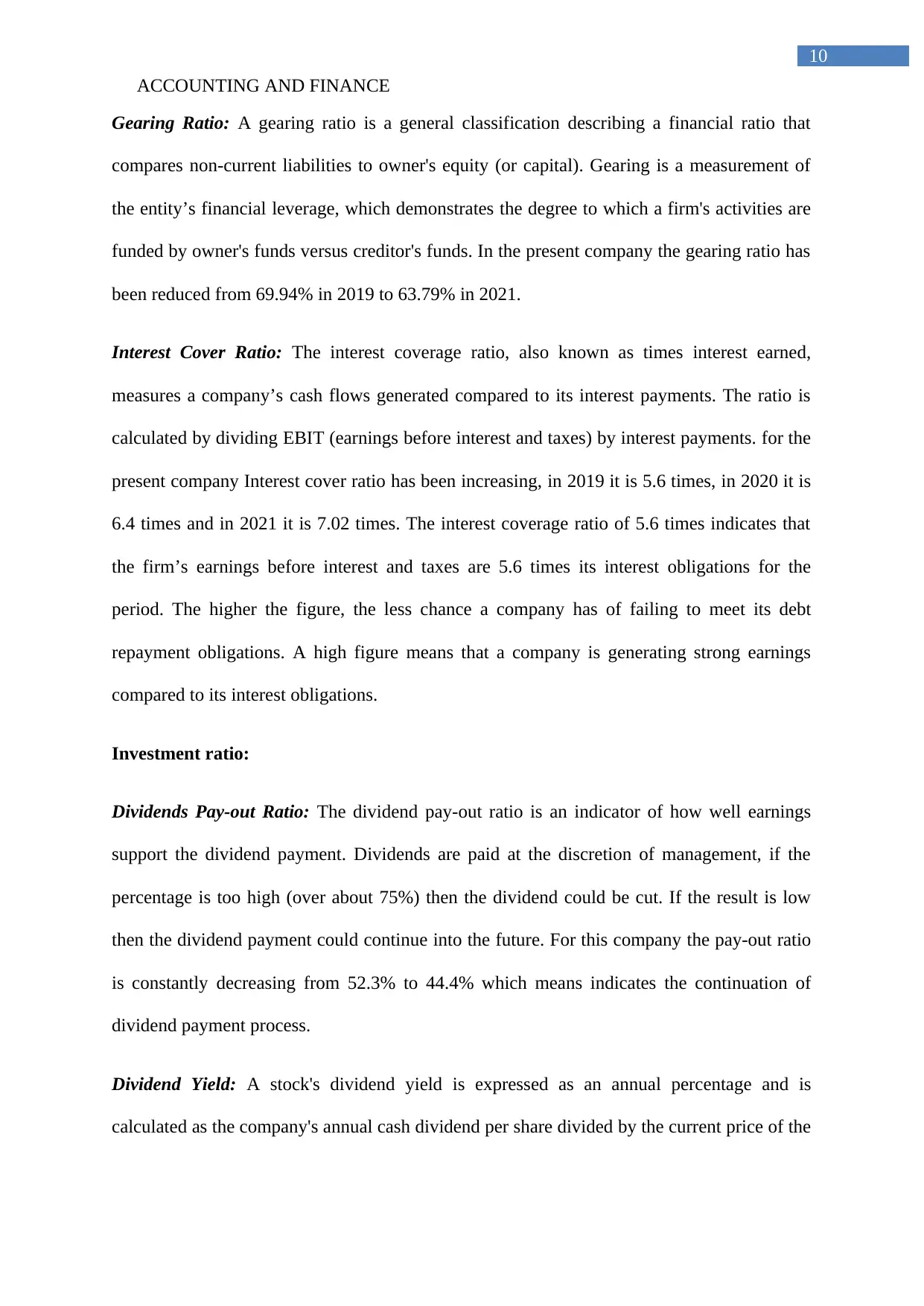
ACCOUNTING AND FINANCE
10
Gearing Ratio: A gearing ratio is a general classification describing a financial ratio that
compares non-current liabilities to owner's equity (or capital). Gearing is a measurement of
the entity’s financial leverage, which demonstrates the degree to which a firm's activities are
funded by owner's funds versus creditor's funds. In the present company the gearing ratio has
been reduced from 69.94% in 2019 to 63.79% in 2021.
Interest Cover Ratio: The interest coverage ratio, also known as times interest earned,
measures a company’s cash flows generated compared to its interest payments. The ratio is
calculated by dividing EBIT (earnings before interest and taxes) by interest payments. for the
present company Interest cover ratio has been increasing, in 2019 it is 5.6 times, in 2020 it is
6.4 times and in 2021 it is 7.02 times. The interest coverage ratio of 5.6 times indicates that
the firm’s earnings before interest and taxes are 5.6 times its interest obligations for the
period. The higher the figure, the less chance a company has of failing to meet its debt
repayment obligations. A high figure means that a company is generating strong earnings
compared to its interest obligations.
Investment ratio:
Dividends Pay-out Ratio: The dividend pay-out ratio is an indicator of how well earnings
support the dividend payment. Dividends are paid at the discretion of management, if the
percentage is too high (over about 75%) then the dividend could be cut. If the result is low
then the dividend payment could continue into the future. For this company the pay-out ratio
is constantly decreasing from 52.3% to 44.4% which means indicates the continuation of
dividend payment process.
Dividend Yield: A stock's dividend yield is expressed as an annual percentage and is
calculated as the company's annual cash dividend per share divided by the current price of the
10
Gearing Ratio: A gearing ratio is a general classification describing a financial ratio that
compares non-current liabilities to owner's equity (or capital). Gearing is a measurement of
the entity’s financial leverage, which demonstrates the degree to which a firm's activities are
funded by owner's funds versus creditor's funds. In the present company the gearing ratio has
been reduced from 69.94% in 2019 to 63.79% in 2021.
Interest Cover Ratio: The interest coverage ratio, also known as times interest earned,
measures a company’s cash flows generated compared to its interest payments. The ratio is
calculated by dividing EBIT (earnings before interest and taxes) by interest payments. for the
present company Interest cover ratio has been increasing, in 2019 it is 5.6 times, in 2020 it is
6.4 times and in 2021 it is 7.02 times. The interest coverage ratio of 5.6 times indicates that
the firm’s earnings before interest and taxes are 5.6 times its interest obligations for the
period. The higher the figure, the less chance a company has of failing to meet its debt
repayment obligations. A high figure means that a company is generating strong earnings
compared to its interest obligations.
Investment ratio:
Dividends Pay-out Ratio: The dividend pay-out ratio is an indicator of how well earnings
support the dividend payment. Dividends are paid at the discretion of management, if the
percentage is too high (over about 75%) then the dividend could be cut. If the result is low
then the dividend payment could continue into the future. For this company the pay-out ratio
is constantly decreasing from 52.3% to 44.4% which means indicates the continuation of
dividend payment process.
Dividend Yield: A stock's dividend yield is expressed as an annual percentage and is
calculated as the company's annual cash dividend per share divided by the current price of the
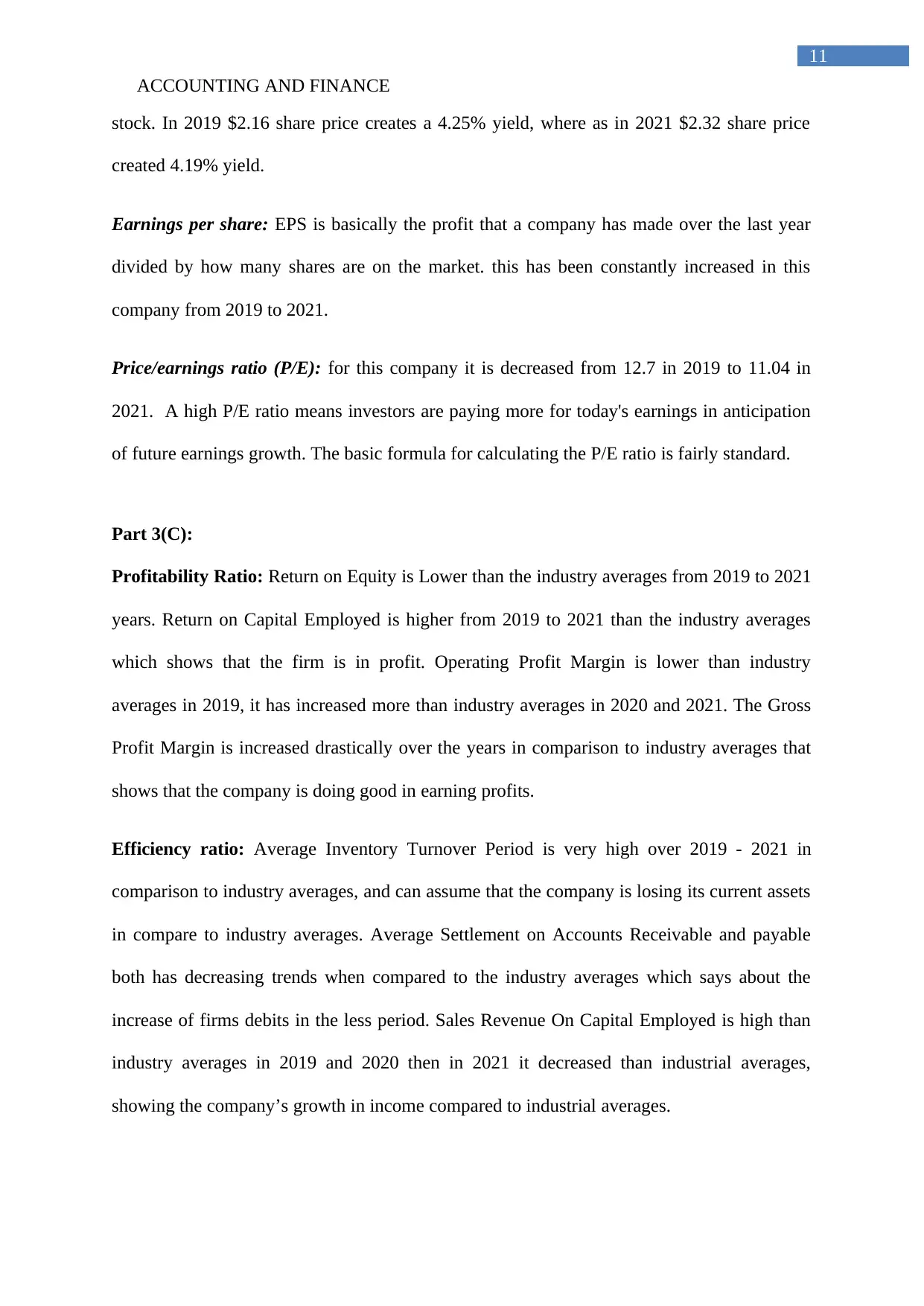
ACCOUNTING AND FINANCE
11
stock. In 2019 $2.16 share price creates a 4.25% yield, where as in 2021 $2.32 share price
created 4.19% yield.
Earnings per share: EPS is basically the profit that a company has made over the last year
divided by how many shares are on the market. this has been constantly increased in this
company from 2019 to 2021.
Price/earnings ratio (P/E): for this company it is decreased from 12.7 in 2019 to 11.04 in
2021. A high P/E ratio means investors are paying more for today's earnings in anticipation
of future earnings growth. The basic formula for calculating the P/E ratio is fairly standard.
Part 3(C):
Profitability Ratio: Return on Equity is Lower than the industry averages from 2019 to 2021
years. Return on Capital Employed is higher from 2019 to 2021 than the industry averages
which shows that the firm is in profit. Operating Profit Margin is lower than industry
averages in 2019, it has increased more than industry averages in 2020 and 2021. The Gross
Profit Margin is increased drastically over the years in comparison to industry averages that
shows that the company is doing good in earning profits.
Efficiency ratio: Average Inventory Turnover Period is very high over 2019 - 2021 in
comparison to industry averages, and can assume that the company is losing its current assets
in compare to industry averages. Average Settlement on Accounts Receivable and payable
both has decreasing trends when compared to the industry averages which says about the
increase of firms debits in the less period. Sales Revenue On Capital Employed is high than
industry averages in 2019 and 2020 then in 2021 it decreased than industrial averages,
showing the company’s growth in income compared to industrial averages.
11
stock. In 2019 $2.16 share price creates a 4.25% yield, where as in 2021 $2.32 share price
created 4.19% yield.
Earnings per share: EPS is basically the profit that a company has made over the last year
divided by how many shares are on the market. this has been constantly increased in this
company from 2019 to 2021.
Price/earnings ratio (P/E): for this company it is decreased from 12.7 in 2019 to 11.04 in
2021. A high P/E ratio means investors are paying more for today's earnings in anticipation
of future earnings growth. The basic formula for calculating the P/E ratio is fairly standard.
Part 3(C):
Profitability Ratio: Return on Equity is Lower than the industry averages from 2019 to 2021
years. Return on Capital Employed is higher from 2019 to 2021 than the industry averages
which shows that the firm is in profit. Operating Profit Margin is lower than industry
averages in 2019, it has increased more than industry averages in 2020 and 2021. The Gross
Profit Margin is increased drastically over the years in comparison to industry averages that
shows that the company is doing good in earning profits.
Efficiency ratio: Average Inventory Turnover Period is very high over 2019 - 2021 in
comparison to industry averages, and can assume that the company is losing its current assets
in compare to industry averages. Average Settlement on Accounts Receivable and payable
both has decreasing trends when compared to the industry averages which says about the
increase of firms debits in the less period. Sales Revenue On Capital Employed is high than
industry averages in 2019 and 2020 then in 2021 it decreased than industrial averages,
showing the company’s growth in income compared to industrial averages.
⊘ This is a preview!⊘
Do you want full access?
Subscribe today to unlock all pages.

Trusted by 1+ million students worldwide
1 out of 22
Related Documents
Your All-in-One AI-Powered Toolkit for Academic Success.
+13062052269
info@desklib.com
Available 24*7 on WhatsApp / Email
![[object Object]](/_next/static/media/star-bottom.7253800d.svg)
Unlock your academic potential
Copyright © 2020–2025 A2Z Services. All Rights Reserved. Developed and managed by ZUCOL.





